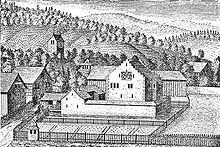Landvogtei Knonau
The Landvogtei Knonau was a historical administrative unit in the city-state of Zurich . It existed from 1507 to 1798 and covered roughly the same area as today's Affoltern district , which is still called Knonauer Amt today.
history
The city of Zurich acquired various areas west of the Albis in the 15th and early 16th centuries . In 1406 they acquired the former rule Schnabelburg , from which the Bailiwick of Horgen and the Maschwander office emerged. During the conquest of Aargau at the request of Emperor Sigismund , they annexed the Freiamt Affoltern in 1415 . The bailiwicks of Hedingen (1503) and Knonau (1512) were added later. In 1507, the City Council of Zurich decided to combine the various properties on the other side of the Albis and manage them as the Outer Bailiwick .
The bailiff resided at Knonau Castle , which the city built for this purpose. His appointment was made by the authorities of the city of Zurich and the term of office was limited to six years. There were strategic reasons for choosing the bailiff's seat on the border with central Switzerland. With the official law of 1535, the existing customary law was systematically written down. With this, Zurich implemented a standardization of the legal system in the Landvogtei Knonau. It is unclear whether the free farmers of the Freiamt were able to retain their privileged legal status under the rule of the city of Zurich.
At irregular intervals found until 1795 in the church Mettmenstetten the Freiamt municipality , attended by the men of the bailiwick of Knonau participated. There the candidates for the post of subordinate and other officials could stand for election. The men entitled to vote then submitted a three-way proposal to the Zurich authorities. The council selected from these a new official for life - usually the one with the highest number of votes.
The Landvogtei existed until the end of the Ancien Régime in Switzerland (1798). After a period in which the administrative structure changed frequently, the Upper Office Knonau was created with the Restoration Constitution of 1814 , today's district of Affoltern. The communities of Bonstetten , Stallikon and Wettswil were added to the district . In 1837 the district administration moved from the traditional main town of Knonau to the centrally located village of Affoltern am Albis.
structure
The Landvogtei Knonau was divided into five court circles, each of which was headed by a subordinate. The sub-bailiff of the Affoltern court district bore the title of Freiamtmann . Some of the judicial circles respected previously existing boundaries. The Affoltern and Knonau districts together formed the Freiamt district, the Maschwanden and Hausen districts the Maschwander Amt district.
- Affoltern court district (or Freiamtsgericht)
- Ferenbach
- Twin icon
- Affoltern am Albis
- Unterlunnern (lower part)
- Toussen (upper part)
- Roof louvers
- Untermettmenstetten
- Wissenbach
- Rossau
- Knonau District Court
- Knonau
- Obermettmenstetten
- Aeugst
- Borsikon (today Chloster in Aeugstertal )
- Breitenmatt (today Habersaat in Aeugstertal )
- Maschwanden court district
- Maschwanden
- Ottenbach
- Rickenbach
- Wolsen
- Unterlunnern (upper part)
- Oberlunnern
- Toussen (lower part)
- Bickwil
- Kappel am Albis
- Ebertswil
- Main icon
- Uerzlikon
- Rifferswil
- Herferswil
- Hirzwangen
- Hausen District Court
- Hausen am Albis
- Schweikhof
- Hot
- Tüfenbach
- Vollenweid
- Langnau am Albis with Rängg
- Hedingen District Court
Peripheral areas
The Landvogtei Knonau also had high jurisdiction over Steinhausen and the cellar office . This connection between these areas has existed since the times under Habsburg rule. According to the adopted law, a violation of the law by a Freiämtler was judged in the cellar office there and vice versa. The cellar office belonged to the common rule of all federal estates and had remained Catholic during the Reformation, which led to denominational tensions. The high jurisdiction over Steinhausen and the cellar office was separated from the Landvogtei Knonau in 1670 and subordinated directly to the council administration of the city of Zurich. Both peripheral areas, over which Zurich only had the High Court, left the canton's territory in 1803.
coat of arms
Blazon : a black wall anchor cross in gold
The coat of arms of the Knonau office goes back to the barons of Eschenbach -Schnabelburg. It is still used today as the district coat of arms for the Affoltern district.
Individual evidence
- ↑ Martin Illi: Maschwanden. In: Historical Lexicon of Switzerland .
- ^ Bernhard Schneider, History of the Knonau Community, Primusverlag, Affoltern a. A. 1982
- ^ Paul Kläui: History of Obfelden. 1st section . In: History of the community of Obfelden. Festschrift for the centenary of the community . Affoltern am Albis 1947, p. 65-195 (especially 86-94) .
See also
Web links
- Martin Illi: Knonau (Vogtei). In: Historical Lexicon of Switzerland .
- Martin Illi: Freiamt. In: Historical Lexicon of Switzerland .


